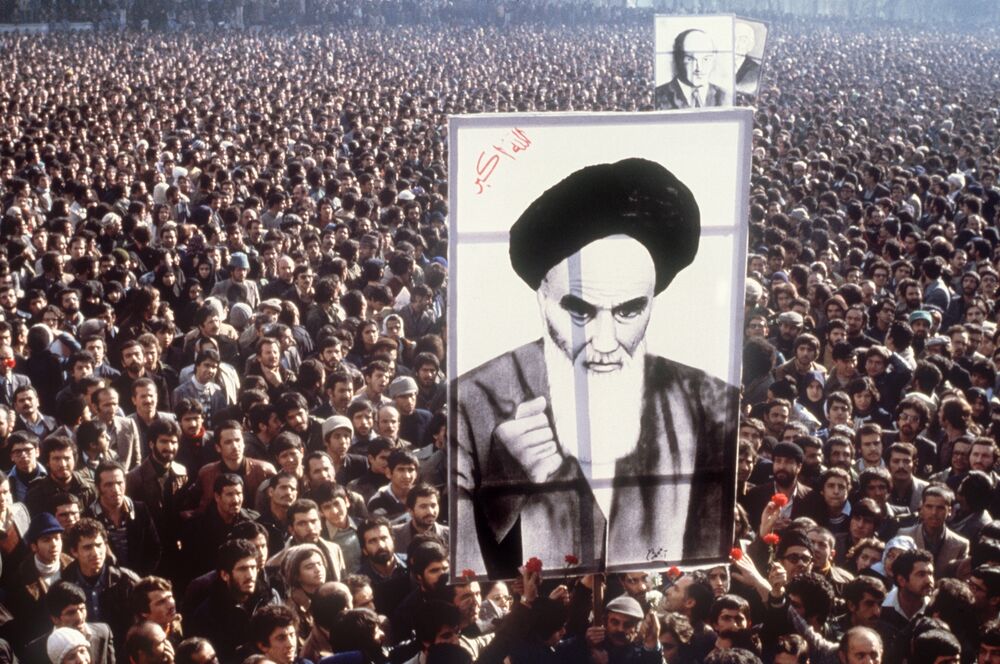Iranians are still suffering 40 years after the last one.
 He just told people what they wanted to hear.
He just told people what they wanted to hear.
Four decades ago, in the months leading up to the Islamic Revolution in Iran, the exiled Ayatollah Ruhollah Khomeini made many promises. He spoke about respecting the rights of minorities, democracy and equality for women.
Western intellectuals like the late French philosopher Michel Foucault praised Khomeini’s vision. In Iran, liberals and communists were happy to join with his followers to topple the corrupt regime of the shah. The charismatic Khomeini was saying what they wanted to hear.
Or, to put it another way: He was lying. Khomeini “was not locked into everything he had said” then, according to Abolhassan Bani-Sadr, the country’s first president after the revolution. Speaking in an interview this month, the former president said that Khomeini described the promises he made before he came to power as “convenient.”
That’s putting it mildly. Soon after declaring himself supreme leader, Khomeini abandoned almost all of his public pledges. In his 2016 book “Democracy in Iran: Why it Failed and How it Might Succeed,” the professor Misagh Parsa describes the post-revolution government of Khomeini as “an exclusive state” that “rejected the promise of democracy.”
The clerics and their enablers had a lot of work to do. They banned alcohol, and popular music on radio and television, and taking your dog for a walk in the park. They also launched a campaign of public cruelty, promulgating decrees to punish adulterers and other criminals with lashes and stoning. In 1988, there were mass executions of as many as 40,000 enemies of the state. Between 1979 and 2009 the regime arrested, imprisoned or killed at least 860 journalists, according to Reporters Without Borders.
To this day, state television broadcasts coerced confessions. It was just last summer that Maedeh Hojabri, a teenaged gymnast, confessed to the crime of posting videos of herself on Instagram dancing without the required hijab.
The cruelty extends to Iranians living abroad. The regime has been known to send assassins to Europe to murder opposition leaders; former Prime Minister Shapour Bakhtiar, who briefly led a reformist government in the last months of the shah’s regime, was stabbed multiple times the chest in his Paris apartment in 1991. Just last week, Iran’s justice minister announced he would begin prosecuting the U.S.-based journalist and activist Masih Alinejad after she met with U.S. Secretary of State Mike Pompeo. She, too, stands accused of encouraging Iranian women to share videos of themselves taking off their hijab.
Meanwhile, as the state built by Khomeini is persecuting its citizens, it is enriching its leaders. In this regard the Islamic Republic today is not very different than the corrupt regime it replaced 40 years ago. The army’s Revolutionary Guard, for example, also functions as a kind of criminal syndicate, controlling large chunks of the country’s economy. The current supreme leader and Khomeini’s successor operates a slush fund worth tens of billions of dollars, according to a 2013 Reuters investigation, built in part on assets the state seized from Iranian citizens.
Many Iranians now realize that their leaders are corrupt and inept. Nationwide protests and strikes began in December 2017 and continue. Ordinary Iranians, at great personal risk, frequently register their dissatisfaction with their rulers in marches, with graffiti and on anonymous social media accounts. Iranians abroad, exiled by choice or by necessity, are beginning to plan for what comes next. Some dissidents are calling for a national referendum on the powers of the supreme leader.
No serious person believes Iran is a democracy. And yet it is still possible to hear, in some quarters of Brussels and Washington, pleasant nonsenseabout the contest of ideas between Iran’s moderates and hardliners. Javad Zarif, Iran’s foreign minister, still sits for fawning interviews and pretends to be the envoy of a free country.
It’s a con that goes back 40 years. On Feb. 16, 1979, the New York Times published a column by a professor of international law at Princeton. The depiction of Khomeini “as fanatical, reactionary and the bearer of crude prejudices,” he wrote, “seems certainly and happily false.” That op-ed was aptly titled, “Trusting Khomeini.”
Too many Western leaders continue to trust Khomeini’s successors. Even now, the European Union and former Secretary of State John Kerry are working to save the 2015 deal limiting Iran’s nuclear program. They believe the Iranian regime’s promise not to build a weapon when much of the agreement expires in less than 15 years.
The good news is that millions of Iranians no longer believe anything this regime says. They have endured the terror, deprivation and cruelty unleashed by the Islamic Revolution 40 years ago. The least Americans and Europeans can do is defend and support them and their struggle for a democratic revolution.
Eli Lake is a Bloomberg Opinion columnist covering national security and foreign policy. He was the senior national security correspondent for the Daily Beast and covered national security and intelligence for the Washington Times, the New York Sun and UPI.



Leave a Reply
You must be logged in to post a comment.